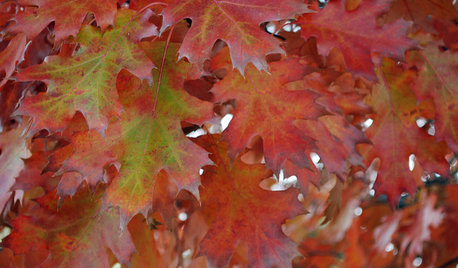black eggs on leaves
sheri_nwok
16 years ago
Related Stories

FALL GARDENING5 Ways to Put Fall Leaves to Work in Your Garden
Improve your soil and yard the organic way with a valuable garden booster that grows on trees
Full Story
FURNITUREDesign Tastemaker: Johnny Egg Gives Decor a Twist
Embracing "theatrical minimalism," the British furniture designer crafts statement pieces that will make you look twice
Full Story
GARDENING GUIDESWhat's Wrong With My Plant? Leaves Often Hold the Clues
Learn how to identify common plant ailments by reading their leaves
Full Story
GARDENING GUIDES6 Healthy Ways to Handle Fallen Leaves
Once nature's beautiful bounty is spent, these ecofriendly strategies for leaves will put your yard in the clear
Full Story
REMODELING GUIDESInterior Brick: Paint it or Leave It?
Here's how to know if covering that brick is a sin or solution
Full Story
LAUNDRY ROOMSRoom of the Day: The Laundry Room No One Wants to Leave
The Hardworking Home: Ocean views, vaulted ceilings and extensive counter and storage space make this hub a joy to work in
Full Story
DECORATING GUIDES9 Easy Ways to Decorate With Autumn Leaves
Give your home a burst of color that can be used Halloween through Thanksgiving
Full Story
HOLIDAYS16 Creative Ways to Hide Easter Eggs
Crack of dawn on Sunday not your ideal thinking time? Just follow our creative egg-hiding ideas and pretend Peter Cottontail did the work
Full Story
COLORDuck Egg Blue, the Friendliest Color Around
This appealing hue transcends trends, spans styles and gets along with many other colors. Could it be right for one of your rooms?
Full Story
COLOR PALETTESEaster Egg Inspiration: 9 Great Ways to Use Pastels
Mint green, light aqua, pale pink, blossom yellow and soft lavender can bring spring beauty into your home
Full StorySponsored
Columbus Area's Luxury Design Build Firm | 17x Best of Houzz Winner!
More Discussions






Okiedawn OK Zone 7
sheepie58
Related Professionals
Allen Landscape Architects & Landscape Designers · Canton Landscape Architects & Landscape Designers · Derry Landscape Architects & Landscape Designers · Mooresville Landscape Contractors · Wake Forest Landscape Contractors · Englewood Landscape Contractors · Homewood Landscape Contractors · Merced Landscape Contractors · Oakland Landscape Contractors · Palatine Landscape Contractors · Saint John Landscape Contractors · West Allis Landscape Contractors · Houston Decks, Patios & Outdoor Enclosures · Lancaster Decks, Patios & Outdoor Enclosures · Salisbury Decks, Patios & Outdoor EnclosuresOkiedawn OK Zone 7
sheri_nwokOriginal Author
sheepie58
sheri_nwokOriginal Author
sheepie58
susanlynne48
sheri_nwokOriginal Author
Okiedawn OK Zone 7